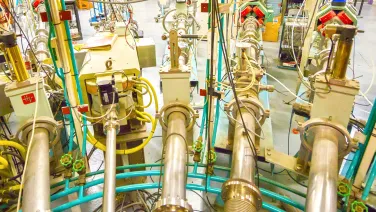ANU partnership to deliver safe innovations in nuclear science

A new partnership between The Australian National University (ANU) and world-leading Los Alamos National Laboratory (LANL) in the United States will deliver innovations in nuclear science and help steward the safe use of nuclear technologies across the globe.
ANU leads the nation’s premier nuclear physics research and training program and is helping advance Australia’s sovereign nuclear capabilities, playing a pivotal role in the AUKUS partnership.
The new partnership has been announced overnight as part of Australian Prime Minister Anthony Albanese’s state visit to the White House in a joint leaders’ statement with US President Joe Biden.
“The Principals welcome the signing of a Memorandum of Understanding between Los Alamos National Laboratory and The Australian National University which will strengthen cooperation in nuclear physics research and education between the United States and Australia,” the statement reads.
The new partnership will draw on the Heavy Ion Accelerator Facility (HIAF) at ANU, which has been leading nuclear science in Australia for 50 years.
“ANU is home to one of the world’s most innovative nuclear science facilities and programs,” Professor Andrew Stuchbery, Head of the ANU Department of Nuclear Physics, said.
“This work is helping protect environmental treasures like the world’s largest coral reef, understand the origins of exotic states of matter and launch space tech into space.
“Under this new partnership ANU and LANL will collaborate on research programs that deliver major benefitS across a range of vital fields including medicine and health, environmental protection, safer mining, quantum computing and the development and testing of new technologies.
“The fact that LANL – one of the greatest nuclear science research facilities in the world – is partnering with Australia’s national university is testament to the quality and value of the work we do here at ANU day in and day out.
“We are proud to partner with LANL and look forward to the important breakthroughs it will deliver for Australia, the US and the rest of the world.”
Under the new agreement ANU and LANL will also see students undertake research projects and hands-on training in the safe use of nuclear science and technologies. This includes applications like radiation simulation and modelling, and cancer therapies.
“These areas are critical requirements for Australia across a range of industries, including nuclear medicine, critical minerals extraction and processing, climate and environmental research,” Dr Thomas McGoram, CEO of Heavy Ion Accelerators and based at the ANU Research School of Physics, said.
“As the home of the only hands-on nuclear physics training in Australia, and housing the world-renowned Heavy Ion Accelerator Facility, ANU plays a unique and critical role in the training of the national nuclear-skilled workforce.
“This partnership will benefit Australia by enhancing the ability of ANU to meet growing needs for a highly-skilled, nuclear literate workforce: a clear priority for AUKUS, but also needed to support Australia’s quantum industry, nuclear medicine, climate and environment research, critical minerals and the space industry.”
The partnership between ANU and LANL is limited to frontier nuclear science and its peaceful applications.
To learn more about ANU nuclear physics research and training, as well as the Heavy Ion Accelerator Facility, visit https://physics.anu.edu.au/research/npaa/.
This article was first published ANU Reporter.



